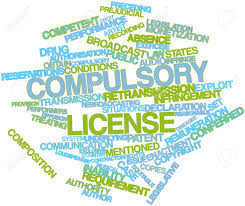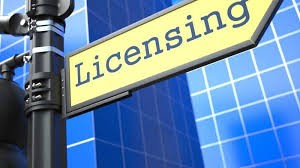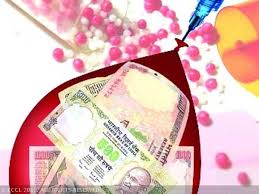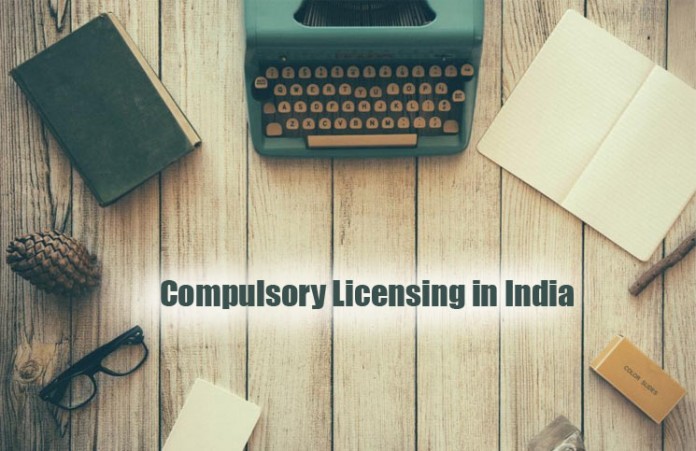In this blog post, Bhavneet Vohra, a student of Vivekananda Institute of Professional Studies, Delhi, and pursuing his Diploma in Entrepreneurship Administration and Business Laws from NUJS, Kolkata, provides an overview on compulsory licensing in India.
Introduction
In India, it is very well established at all statutory, administrative and judicial levels that Intellectual Property is very important. India signed a contract with World Trade Organization which is known as the Trade-Related Aspects of Intellectual Property (TRIPS) which came into force in January 1995. Minimum standards of protection of Intellectual Property rights have been laid down under this agreement.  The Agreement provides for norms and standards in respect of the following areas of intellectual property:
The Agreement provides for norms and standards in respect of the following areas of intellectual property:
- Patents
- Trade Marks
- Copyrights
- Geographical Indications
- Industrial Designs
What is Compulsory Licensing?
One thing we need to understand that patents are provided to encourage the inventions and to protect and secure it in our country India. The Indian Patent Act very well ensures that no Patentee (the person who obtains a patent for his invention) should enjoy the monopoly rights for the importation of patented articles.
Many methods of Compulsory Licensing are provided by the Patent Act to fully ensure that in no way the protection of public health and the nutrition of the people is compromised by any means. Moreover, it also provides measures so that the Patentee does not abuse patent rights.
The main purpose of Compulsory Licensing is as follows:
- To reward the patentees for their particular invention
- So that the large population in developing and under developed countries can get easy access to pharmaceutical products particularly at a lower and affordable price.
Which section of the Indian Patent Act relates to the Compulsory Licensing?
It is the Section 84 of the Indian Patent Act that relates to the Compulsory Licensing.
Section 84: Grant of compulsory license due to “Non- working/Unaffordable Prices of patented article.
According to Section 84, Compulsory Licenses are granted for the following purposes:
- For the prevention of abuse of the patent as a monopoly
- For making a path to the commercial exploitation of the interested person of the patented article.
- For the purpose of addressing public health concern in India.
As per the section it is to be noted that any person interested or who is already the holder of the license under the patent can make request to the Controller for grant of Compulsory License on patent after three years from the “date of grant” from the date of grant of that patent, which is listed as per the following grounds listed below:
- When it does not satisfy the reasonable requirements of the public
- When there is no availability of the patented invention to the public at affordable price
- When there is no working of the patented invention in India
What are the aspects which the Controller takes into consideration while granting a Compulsory license?
The controller takes into consideration the following aspects which are listed below:
- Nature of the Invention
- Since the grant of the patent, the time which has elapsed
- To make full use of the inventions the measures that patentee or any licensee takes.
- If the applicant can use the patent for the benefit and good of the public
- If the applicant has enough capacity for undertaking the risk to provide capital and working the invention
Compulsory License with respect to Export of Pharmaceutical Products
On January 1, 2005, Indian Patent Act was amended, and it was at that time Section 92 (A) was inserted for the purpose of grant of CL for export of pharmaceutical products in certain exceptional circumstances.
According to the Section 92 (A) which says that CL can only be granted if the importing country has also granted CL or has by notification, or otherwise, allowed importation of the patented pharmaceutical products from India.
When the first Compulsory License of the patent was given in India?
It was recently in the year 2012 on March 9 Patent office in India granted its first compulsory license to Natco Pharma Ltd for the purpose of producing a generic version of Bayer’s Corporation’s Patented Medicine Nexavar which is used in the treatment of liver and kidney cancer.
All the three grounds that were listed in the Patents Act were taken into consideration by the Controller for deciding against the Bayer for the purpose of grant of Compulsory License which is as follows:
- Unsatisfied reasonable requirements of the Public
- When it is not available to the public at a reasonable, affordable price
- When the Patented Invention was not being worked in the Indian territory
Bayer Corporation was selling the drug at a whopping price of INR 2.80 lakhs for a month’s course, which in turn was promised by Natco that it would make available the same drug to the public only at 3% of the price that makes INR 8800 of what was charged by Bayer Corporation. 6% of the net sales was directed to pay as royalty to Bayer by Natco. Apart from this Natco was also directed to sell the drug only within the Indian Territory and also supply the drug to at least 600 deserving patients free of cost per year.
Bayer became aggrieved by the Controller’s decision which made him move to the Intellectual Property Appellate Board (IPAB) alleging that the grant of CL was illegal and unsustainable. But this plea was immediately rejected by the Board claiming that it would have adverse- affect and even jeopardize the interest of the public who are suffering from the disease and require the drug at a later stage. It was also held that it was a matter of dignity for the public to get the drug at a cheaper rate.
On March 4, 2013, the Board Chief Prabha Sridevan dictated the order in an open court upholding the Controller’s decision for grant of CL on Bayer’s patented drug, which was named as Sorafenib Tosylate.
 Serato DJ Crack 2025Serato DJ PRO Crack
Serato DJ Crack 2025Serato DJ PRO Crack











 Allow notifications
Allow notifications



